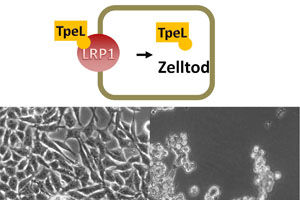Gate for Bacterial Toxins Found
Researchers discover a molecule that smuggles toxins from intestinal pathogens into human cells
Advertisement
Prof. Dr. Dr. Klaus Aktories and Dr. Panagiotis Papatheodorou from the Institute of Experimental and Clinical Pharmacology and Toxicology of the University of Freiburg have discovered the receptor responsible for smuggling the toxin of the bacterium Clostridium perfringens into the cell. The TpeL toxin is formed by C. perfringens, a pathogen that causes gas gangrene and food poisoning. It is very similar to the toxins of many other hospital germs of the genus Clostridium. The toxins bind to surface molecules and creep into the body cell, where they lead to cell death. “In order to prevent the toxin from entering the cell, it is necessary to find the receptor that serves as the gatekeeper. But the search for this key molecule remained unsuccessful for a long time,” says Aktories, member of the Cluster of Excellence BIOSS Centre for Biological Signalling Studies. In cooperation with colleagues from Düsseldorf, the USA, and the Netherlands, the researchers from Freiburg have now identified a receptor for a clostridial toxin of this type for the first time ever. Their findings were published in the journal Proceedings of the National Academy of Sciences (PNAS).

The cell of the host absorbs the clostridium perfringens toxin TpeL via the receptor LRP1. The toxins then destroy the cell from within. (left: cell culture without toxins; right: cell culture after toxins were applied).
Panagiotis Papatheodorou
Clostridia cause intestinal and wound diseases in humans and animals that are often fatal. “At the moment, infections with the bacterium Clostridium difficile are particularly problematic in hospitals. The diseases tend to appear following treatment with antibiotics and often lead to diarrhea, but also to fatal inflammations of the bowels,” explains Aktories. The toxins force their way into host cells and deactivate signaling molecules by attaching a sugar molecule to these cellular switches. Once this signaling pathway has been switched off, the cell dies – infested tissue dies off.
In order to find the receptor, the researchers applied a genetic selection procedure, a so-called screening, in which individual genes in cells from human cancer cell lines are turned off at random. This procedure led to the discovery that cells are immune to the TpeL toxin when the gene for the protein LRP1 is switched off on the cell surface. LRP1, which stands for low density lipoprotein receptor-related protein 1, usually takes in proteins that serve as a means of transport for lipids in the blood. The researchers demonstrate that LRP1 is the long sought-after key molecule: It also regulates the intake of the toxin TpeL.
His team also proposes a new model, explains Aktories: “Our findings indicate that two receptors are involved in the effect of the other sugar-carrying clostridial toxins.” Researchers can use the findings to develop new agents against clostridia. “Our discovery will also provide new impetus for researchers to identify further toxin receptors,” Aktories hopes.























































